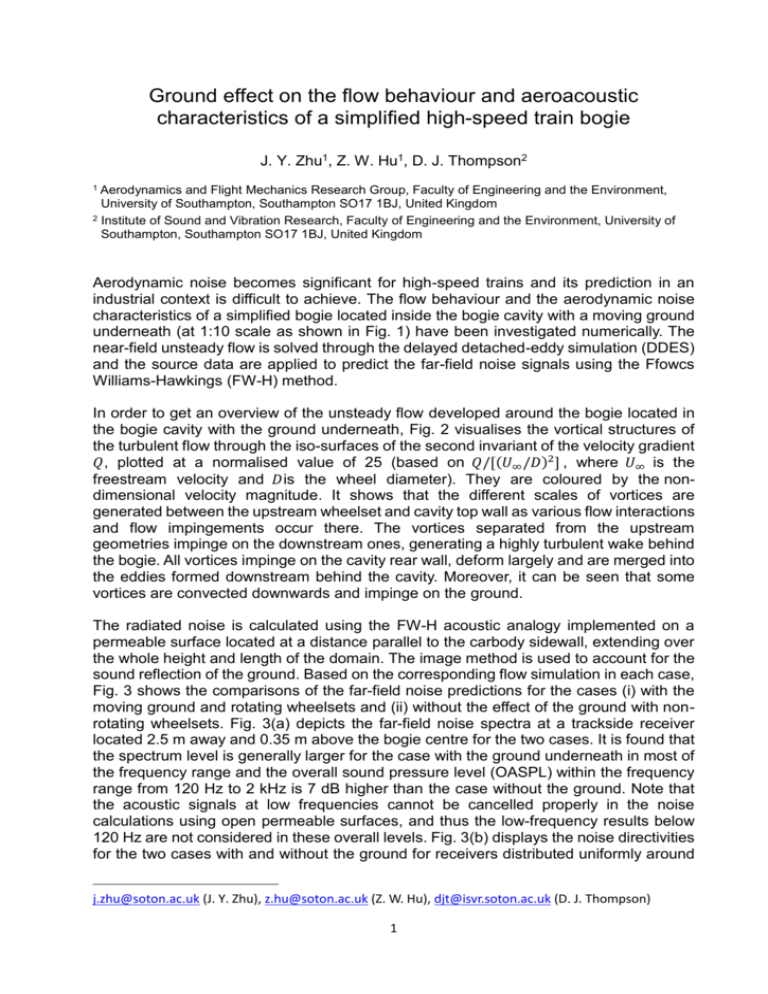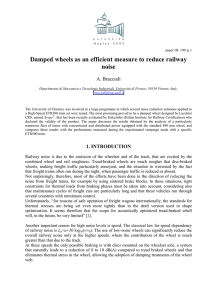Ground effect on the flow behaviour and aeroacoustic characteristics
advertisement

Ground effect on the flow behaviour and aeroacoustic characteristics of a simplified high-speed train bogie J. Y. Zhu1, Z. W. Hu1, D. J. Thompson2 Aerodynamics and Flight Mechanics Research Group, Faculty of Engineering and the Environment, University of Southampton, Southampton SO17 1BJ, United Kingdom 2 Institute of Sound and Vibration Research, Faculty of Engineering and the Environment, University of Southampton, Southampton SO17 1BJ, United Kingdom 1 Aerodynamic noise becomes significant for high-speed trains and its prediction in an industrial context is difficult to achieve. The flow behaviour and the aerodynamic noise characteristics of a simplified bogie located inside the bogie cavity with a moving ground underneath (at 1:10 scale as shown in Fig. 1) have been investigated numerically. The near-field unsteady flow is solved through the delayed detached-eddy simulation (DDES) and the source data are applied to predict the far-field noise signals using the Ffowcs Williams-Hawkings (FW-H) method. In order to get an overview of the unsteady flow developed around the bogie located in the bogie cavity with the ground underneath, Fig. 2 visualises the vortical structures of the turbulent flow through the iso-surfaces of the second invariant of the velocity gradient 𝑄 , plotted at a normalised value of 25 (based on 𝑄/[(𝑈∞ /𝐷)2 ] , where 𝑈∞ is the freestream velocity and 𝐷 is the wheel diameter). They are coloured by the nondimensional velocity magnitude. It shows that the different scales of vortices are generated between the upstream wheelset and cavity top wall as various flow interactions and flow impingements occur there. The vortices separated from the upstream geometries impinge on the downstream ones, generating a highly turbulent wake behind the bogie. All vortices impinge on the cavity rear wall, deform largely and are merged into the eddies formed downstream behind the cavity. Moreover, it can be seen that some vortices are convected downwards and impinge on the ground. The radiated noise is calculated using the FW-H acoustic analogy implemented on a permeable surface located at a distance parallel to the carbody sidewall, extending over the whole height and length of the domain. The image method is used to account for the sound reflection of the ground. Based on the corresponding flow simulation in each case, Fig. 3 shows the comparisons of the far-field noise predictions for the cases (i) with the moving ground and rotating wheelsets and (ii) without the effect of the ground with nonrotating wheelsets. Fig. 3(a) depicts the far-field noise spectra at a trackside receiver located 2.5 m away and 0.35 m above the bogie centre for the two cases. It is found that the spectrum level is generally larger for the case with the ground underneath in most of the frequency range and the overall sound pressure level (OASPL) within the frequency range from 120 Hz to 2 kHz is 7 dB higher than the case without the ground. Note that the acoustic signals at low frequencies cannot be cancelled properly in the noise calculations using open permeable surfaces, and thus the low-frequency results below 120 Hz are not considered in these overall levels. Fig. 3(b) displays the noise directivities for the two cases with and without the ground for receivers distributed uniformly around j.zhu@soton.ac.uk (J. Y. Zhu), z.hu@soton.ac.uk (Z. W. Hu), djt@isvr.soton.ac.uk (D. J. Thompson) 1 a semicircle with 2.5 m radius from the bogie centre in the bogie horizontal central plane. A lateral dipole pattern of noise radiation is predicted with noise levels around 6-8 dB higher for the case with the ground underneath compared with the case without the ground. This is because the moving ground and the rotating wheelsets increase the noise generation (around 20% contributions) and the ground reflection effect increases the sound radiation (about 80% contributions) for the case with the ground. Fig. 1. Model of simplified bogie inside the cavity with the ground underneath (1:10 scale) Fig. 2. Iso-surfaces of the instantaneous normalised 𝑄-criterion (case with the ground) 80 With ground Without ground PSD, dB re (210-5)2Pa2/Hz 70 60 50 40 30 20 10 0 1 10 2 10 Frequency (Hz) 3 10 (a) Noise spectra (b) Noise directivities Fig. 3. Comparisons of far-field noise prediction from the permeable surface 2







